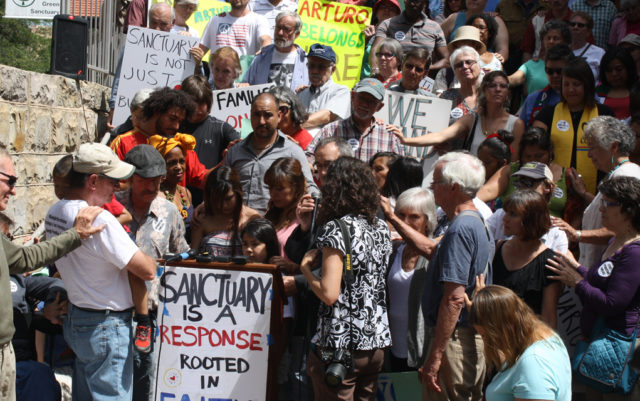
Arturo Hernandez García entered sanctuary on Oct. 21, 2014, the day he was scheduled for deportation. He lived in a Denver church basement for nine months until he received a letter from Immigration and Customs Enforcement (ICE) saying he was no longer a priority for deportation. There was a celebration on the church’s steps. García had become a symbol of, and a de facto spokesperson for, the sanctuary movement.
So he left the church, returned to his wife and two daughters, and resumed work at the business he owns.
On April 26, 2017 — almost two years after leaving sanctuary — ICE arrested García at his workplace. But after an outpouring of support from the immigrant rights advocates, congressional leaders and the community at large, ICE released García from the ICE Denver Contract Detention Facility in Aurora late Tuesday, May 2.
García was granted a 30-day stay of removal “on an order of supervision,” says ICE spokesman Carl Rusnok in an email.
“We are grateful that Mr. Hernandez has been granted a brief reprieve so he can attend his daughter’s high school graduation, as well as allow us time to ask an appeals court to revisit his case,” said García’s lawyer, Laura Lichter, in a statement.
García’s eldest daughter, Mariana, currently has legal status under the Deferred Action for Childhood Arrivals (DACA) program, and she is preparing to graduate high school this year. Her future was the reason García moved to the U.S. in the first place.
García was arrested after an altercation with a co-worker in 2010. A jury eventually cleared him of all charges (after more than $17,000 in legal fees and fines), but ICE still considered him a deportation priority until they sent him the letter indicating otherwise.
Rusnok says ICE is “currently researching the origin of this unsigned and undated note,” which he says was presented to ICE Denver officers by an attorney.
“This apparently two-year-old note (which references a June 2015 contact) was drafted under different ICE immigration enforcement priorities,” Rusnok says.
A group of García’s supporters held a vigil outside the GEO facility in Aurora from the day he was arrested until May 1. Thousands, meanwhile, signed a petition to release him from detention.
Because García was granted only a short reprieve, he’ll need a long-term solution to remain in the U.S. Rusnok says García has overstayed his original six-month visa by 14 years and has “exhausted his petitions” through the courts and ICE. In her statement, Lichter, however, said the added time will allow García’s legal team to pursue “viable legal options,” and revisit “missed opportunities” with the permanent residency process. García has had a petition for legal status via his in-laws that has been in progress since 2005.
Ana Sauzameda, García’s wife, says in the months since García left sanctuary, the family had been living “a normal, happy, kind of boring life.” They had no suspicion that ICE was going to arrest García, but like many immigrants — here both legally and not — fear of deportation impacted their lives.
“We did feel fear ever since he left sanctuary but in particular after the new administration was elected, after all the rhetoric,” Sauzameda says. “We started to feel more afraid and began to think it was more likely, but we never thought it would happen so soon.”
Sauzameda says that when García told an ICE officer about the letter, he was told, “the letter had been issued under a previous administration and the new administration would not be honoring those promises.”
Jeanette Vizguerra, a mother currently in sanctuary at the First Unitarian Society of Denver (where García also took sanctuary), said last week that she has known García for four years and had seen how his arrest impacted his family.
“In one moment, we see that the life of Arturo’s family could be permanently changed,” says Vizguerra, who was named as one of TIME’s “100 Most Influential People” for her advocacy work and move to sanctuary. “I’m very close with Arturo’s daughter, and we were chatting last night, and there she was going through the articles on Facebook about her father up until late, worried about what will happen. … I don’t think that those who are running the system understand how many children are being impacted so much by this.”
Even though García was released, those close to him questioned what changed in his case.
“We should all be really clear that the administration is being extremely disingenuous when it says it’s only going after people who are dangerous,” says Mike Morran, pastor at First Unitarian Society of Denver. “Let’s be clear that the crime he’s committed of, overstaying his visa, is a misdemeanor, and in a country that follows rule of law, the punishment that Arturo and his family are being subjected to for a misdemeanor is obscene.”
Reverend Noll Anderson of the Church World Service, which helps coordinate sanctuary activities, says only ICE can say for sure if García was targeted for his sanctuary stay, but that the impact immigration rights campaigns have on policy has changed with the new administration.
Jennifer Piper, interfaith organizer for the American Friends Service Committee, says she thinks the change in administration is likely tied to García’s arrest, and the arrest of others in similar situations.
“I do believe that the change in the administration shifted the way ICE thought about Arturo,” Piper says. “I think that I speak for folks who are engaged in sanctuary across the country that we deeply understand how serious the administration is about their priorities and taking people out of our communities.”














